He raises his nose in the air and sniffs at the air, trying to get our scent, but the wind isn’t cooperating with him. He knows we are there, but what we are is a mystery. Just as I’ve never seen a polar bear before, this polar bear has most likely never seen a human before. Since the polar bear’s eyesight isn’t great, they rely on their sense of smell to assess a new situation. He stares right at us, curiosity in his expressions; could we be lunch, should we be feared, or are we harmless. He comes a bit closer; we drift a bit closer. Suddenly he catches it and he has what he wants – our scent. He promptly turns and runs away. This was the beginning of many animals in the Arctic encounters around Wrangel Island.
The Arctic Region, and Wrangel Island in particular, are appealing to travelers for a few reasons.
• It’s remote and rugged
• Few people get to go there
• It’s known for wildlife
Animals in the Arctic
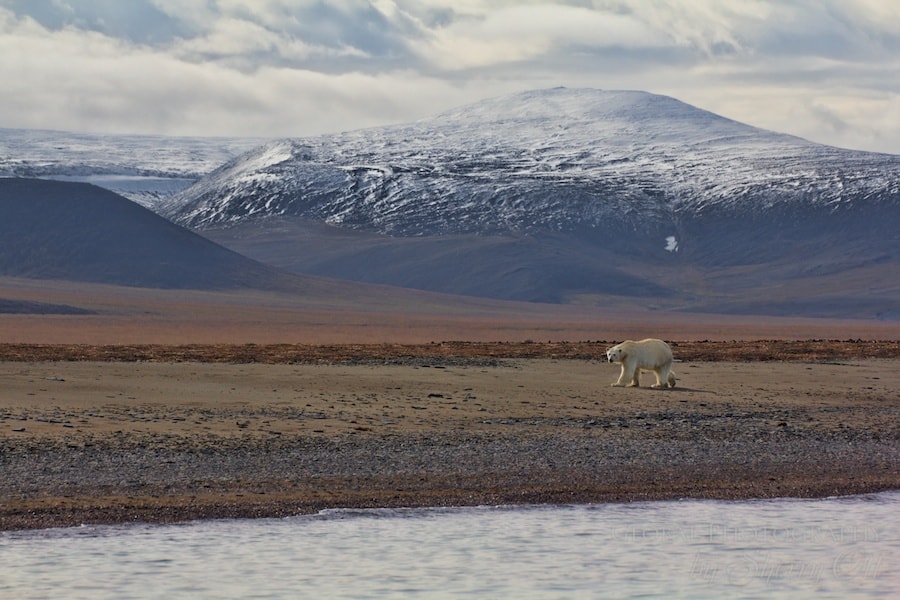
Beautiful Wrangel Island and it’s wildlife
Polar Bears
Humans want to see polar bears, bears don’t want to see us. This is an important fact to keep in mind when viewing these gentle looking creatures.
The Arctic islands play important role in the polar bear life cycle. They need alternative platforms to survive if and when the ice disappears. Wrangel Island is perfect for them; it’s a big landmass with diverse landscape in the midst of a highly productive marine habitats. There is optimal hunting (yes…those walrus could be lunch…) in surrounding sea and island. But the polar bears on Wrangel are in decline, much like the sea ice. Since 1990 optimal ice habitats are disappearing the number of females that den on Wrangel has decreased about four times compared to the 1990s. Not only does Mother Nature play a role in this, but so do humans and poaching.
We arrived at Wrangel Island right when the sea ice had disappeared and most of bears had just come ashore. They seemed all pretty fat and happy.
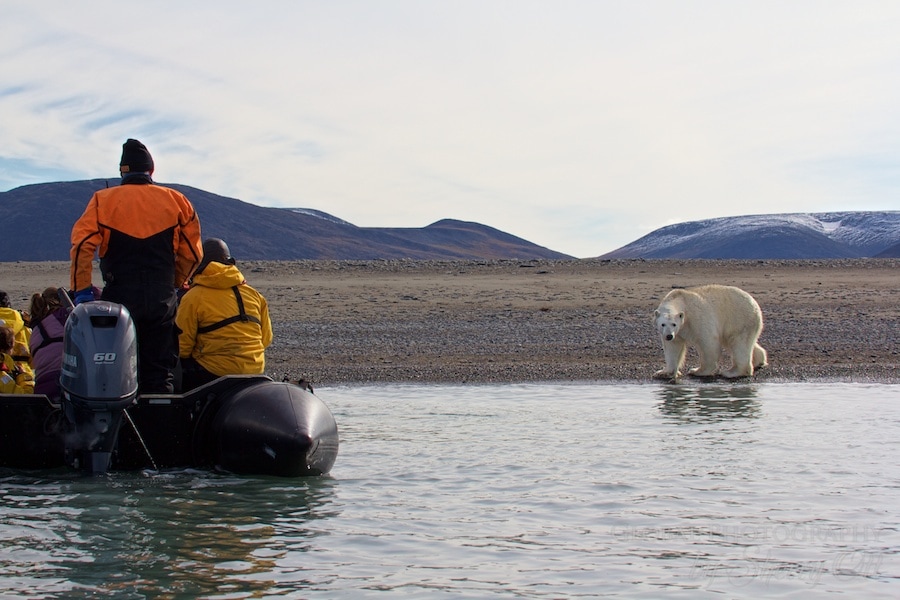
Close encounters…with our skilled expedition leaders
Our expedition leader and the owner of family-run Heritage Expeditions, Rodney, had a methodical, patient way of approaching the polar bears on shore via zodiac. I was fascinated with his slow determination. He led our little group of expedition zodiacs towards the shore where he had spotted a bear napping or hanging out with her cub. While we were still quite far away, Rodney would cut the engine to a crawl and we would proceed the rest of the way very slowly, drifting towards the bear. Rodney was always aware of the direction of the wind and was careful to avoid giving the bear our scent too early if possible. Then once we were close he’d cut the engine completely and we’d float slowly towards shore. The bear would be curious trying to understand what we were and catch our scent. The bear would come a closer depending on his curiosity and this slow process would finally culminate in us being within 15 to 40 feet of the bear on shore. All you could hear was a whir of camera shutters on burst shooting off pictures like a machine gun.
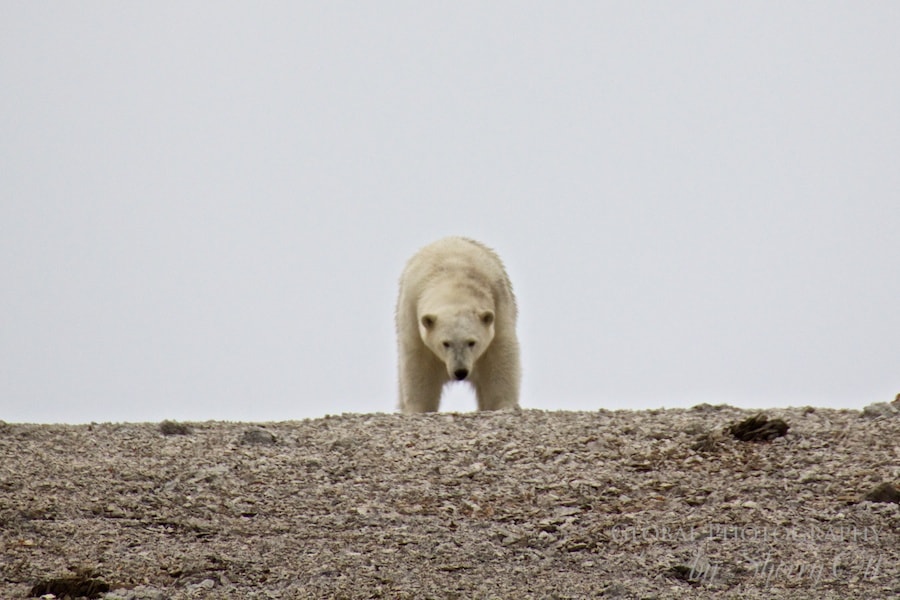
This is one of my favorite pics I took of the bears. Not sure why – it just makes me happy.
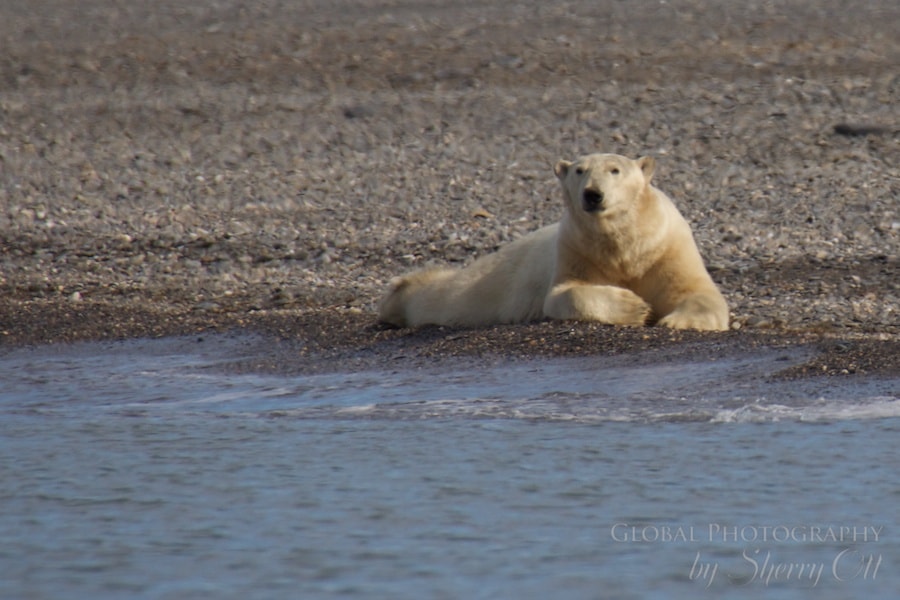
Relaxing by the shore…everyone needs a little beach time.
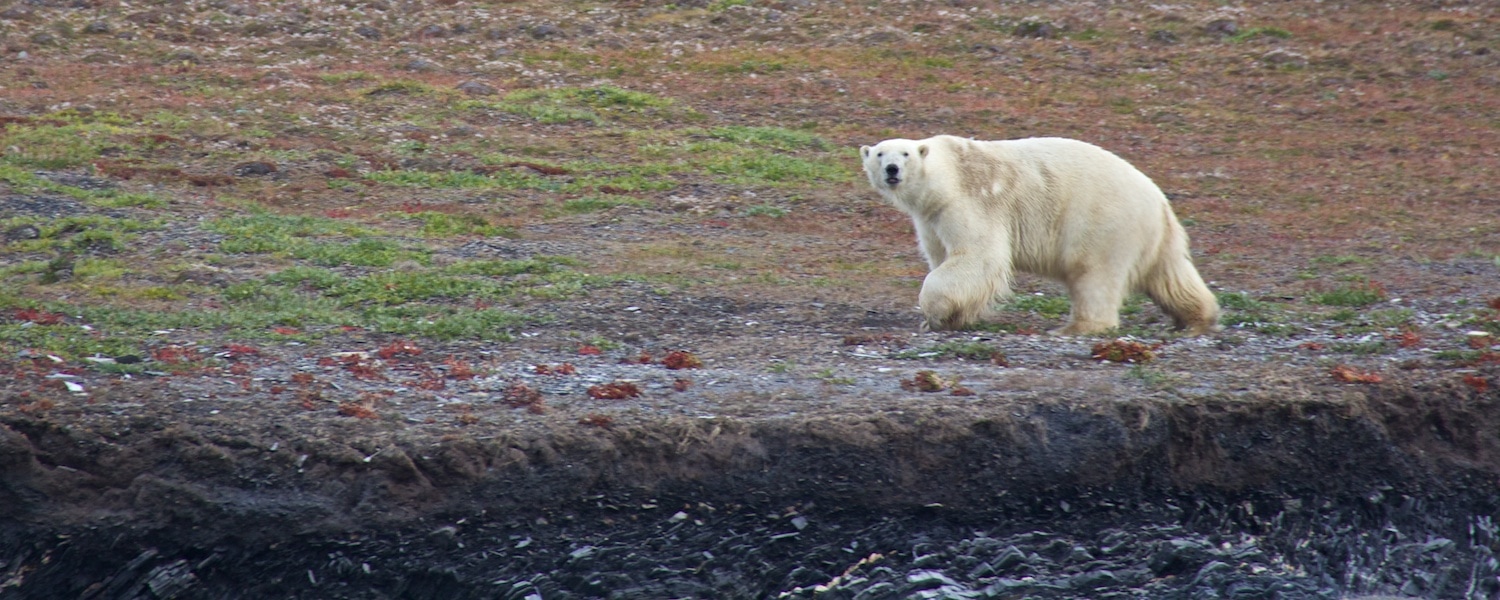
A polar bear walks along the shore keeping an eye on us.
But it’s not just about Polar Bears…the rest of the animals of the Arctic are amazing!
Walrus
The thing that photographs can’t really transmit about animals is their smell. And it was a smelly day around Kolyuchin Island at the walrus haul-out. There must have been 500+ walruses laying on every inch of beach they could find. Some were on top of one another, some intertwined; these giant creatures looked like puzzle pieces from a distance. Our expedition leader, Rodney, made sure that we stayed our safe distance so that we wouldn’t spook them and cause a stampede. I have no idea what a walrus stampede is like, but I didn’t really want to find out. They are giant creatures!
However, much to my surprise they were a curious animal. A group of about 15 came slowly swimming out towards the direction of our boats on a bit of reconnaissance mission to figure out who and what we were. They’d snort and blow their way closer, ever so slowly – then they’d spook themselves and retreat a little. After a bit, they came again. All 5 zodiacs sat quietly bobbing in the swell in awe of how close the curious group came, allowing us to take fabulous pictures. I realized that besides the infamous walrus teeth/tusks, I knew very little about what they looked like, until I started zooming in on them with my 500mm lens and practicing my telephoto photography. I could get so close that I could see the whiskers on their flat nose!
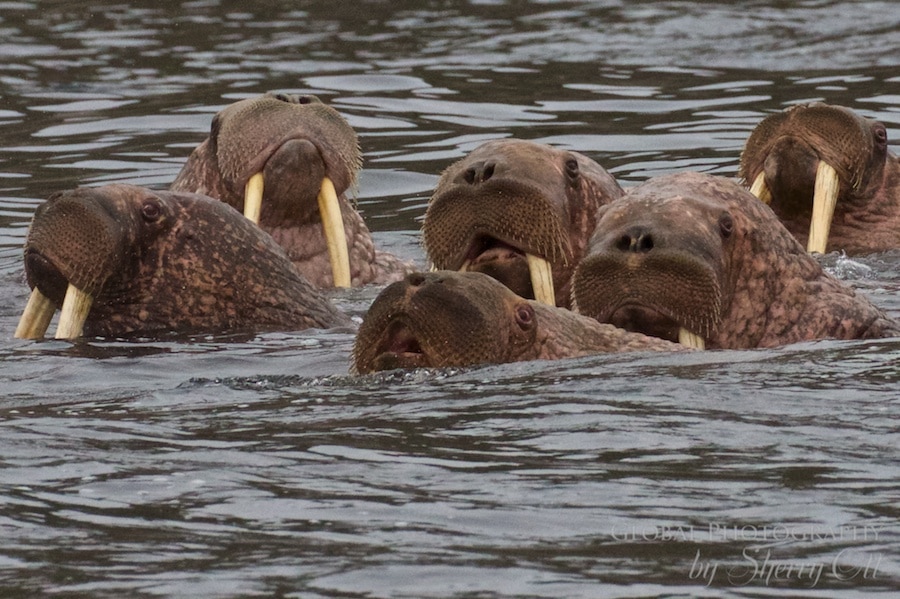
A group of curious young walrus check us out
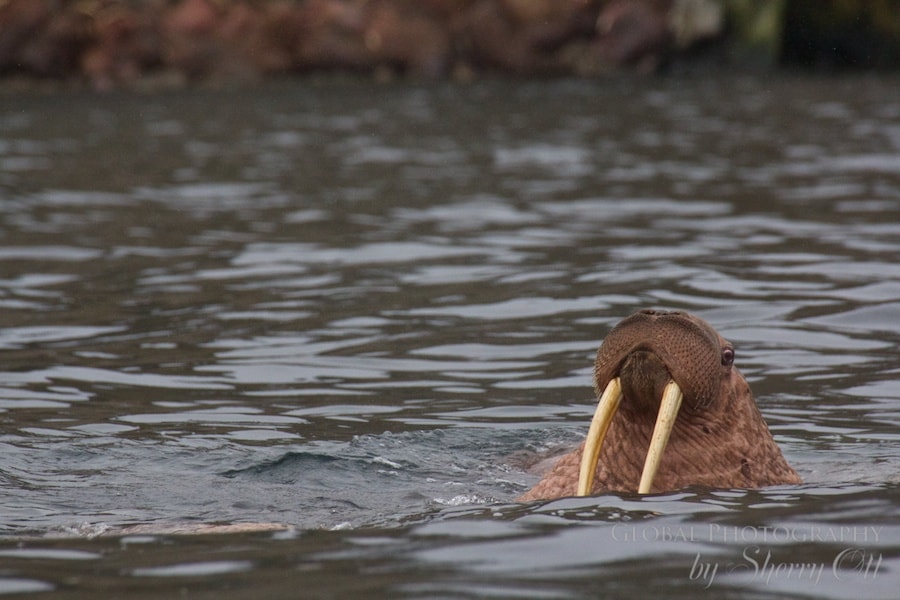
Walrus encounter!
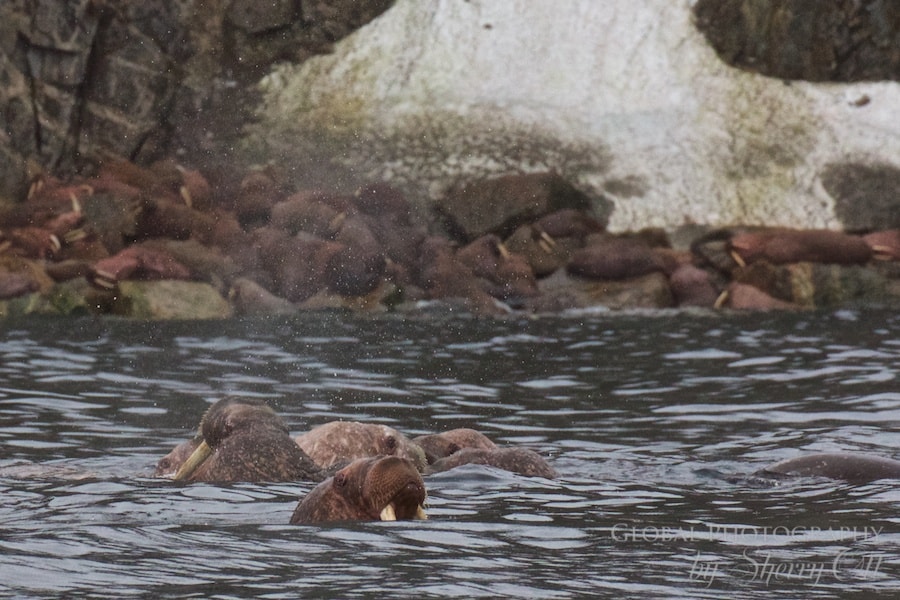
The rest of the walrus keep their distance on shore.
Whales
We saw many whales on this expedition. We encountered mainly encountered Humpback whales, but there was also the occasional Orca and Finn Whale too. They are really amazing to view from a zodiac in the water – scanning the water intently wondering when they would appear. It’s a game of anticipation, strategy, fast camera skills, and luck when it comes to capturing whales in photos.
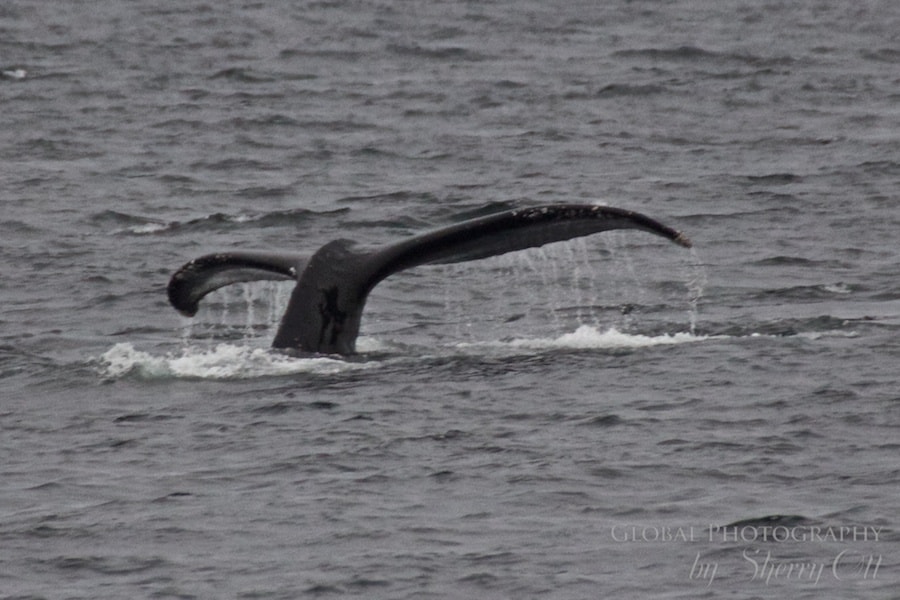
Getting that special whale tail shot!
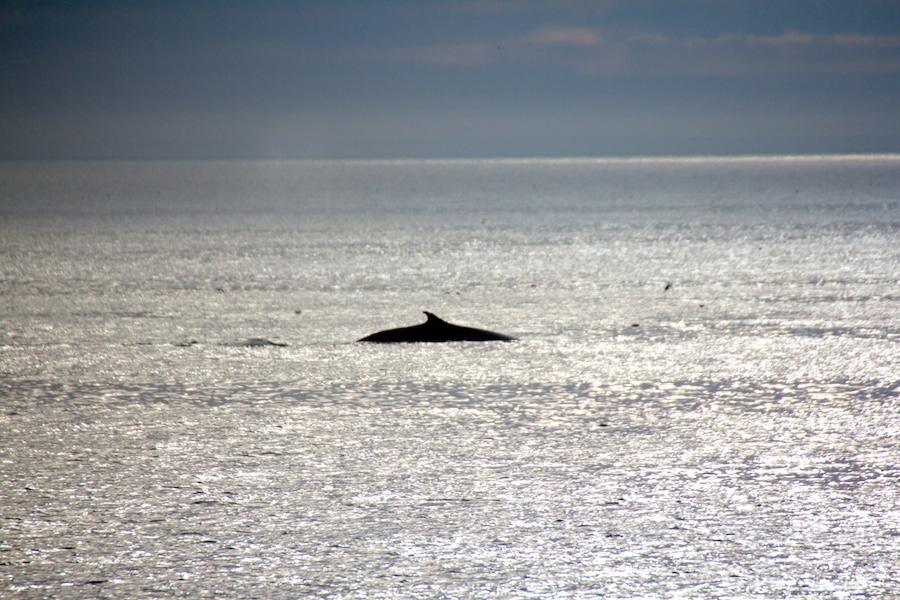
Loved this encounter at dusk when the light sun was lower.
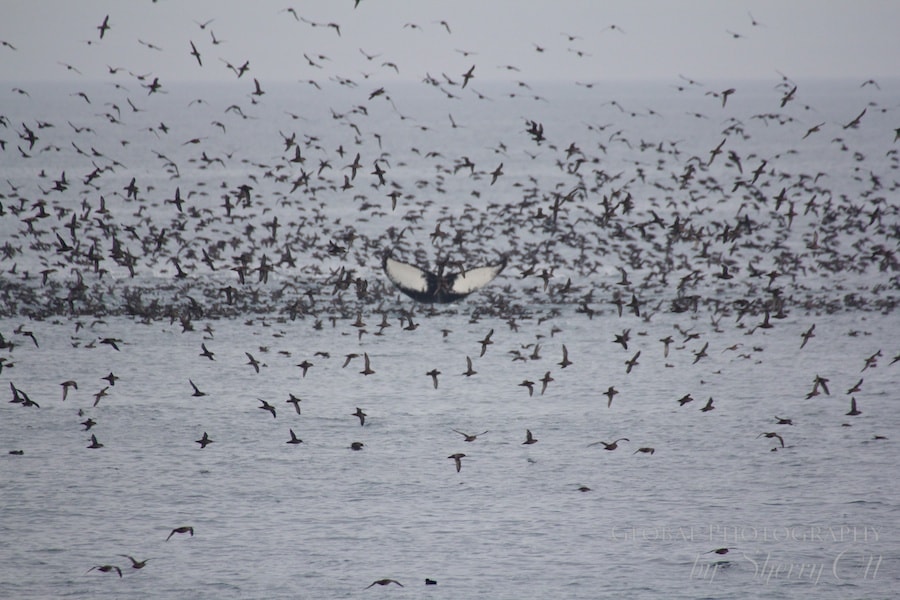
A feeding frenzy…
However, one of the most memorable and touching experiences happened with whales and birds on this trip, leaving many people in tears of awe, including the expedition leaders. Here’s the recount of it from our the Spirit of Enderby’s Log,
“A huge flock of Short-tailed Shearwaters had been spotted in the Bering Strait. The captain slowed the ship to approach them and we determined that there were literally thousands and thousands of them flying or just resting on the water. Right in the middle of this group of birds we could see some Fin and Humpback Whales feeding. It was just an incredible moment for all of us including the expedition staff to see this concentration of birds all gathered in one place. We could hear the beat of their wings as they took to the air while the whales were blowing right next to the ship! The emotion in Rodney’s voice over on the PA indicated that this was a moment rarely experienced.”
One of my favorite videos I was ever lucky enough to catch… the sounds of the birds and the whales will stick in my mind forever as one of those ‘Wild Kingdom’ moments of a lifetime.
But wait…there’s more…
Muskoxen
I thought someone was showing me an image of some prehistoric/extinct animal when I first saw an image of a Muskox. But when I learned that they are real and found on Wrangel Island, I was excited to see such a creature. We didn’t encounter many, and the one we were able to get close to was pretty old and haggard – which made him all the better to photograph!
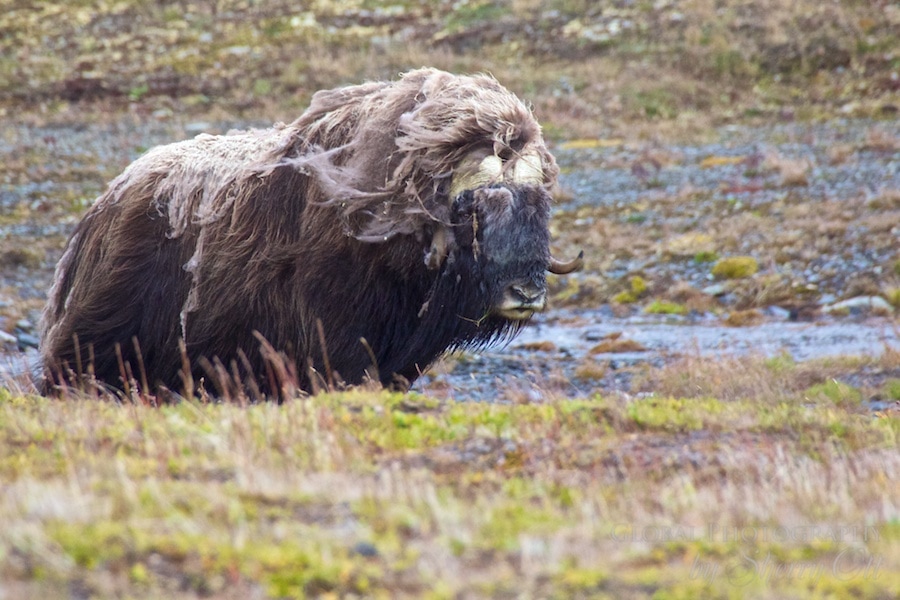
An old muskox without a herd.
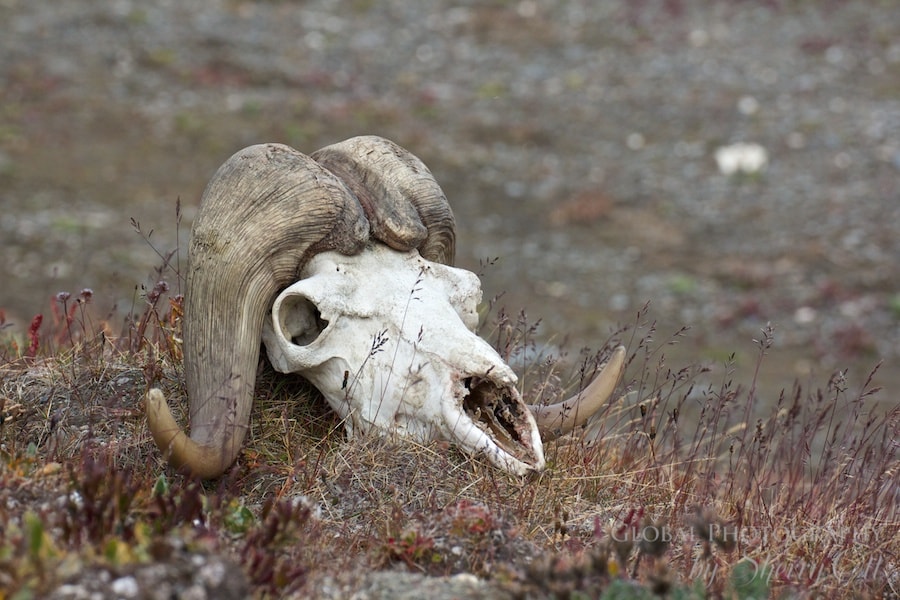
A Muskox skull on the tundra
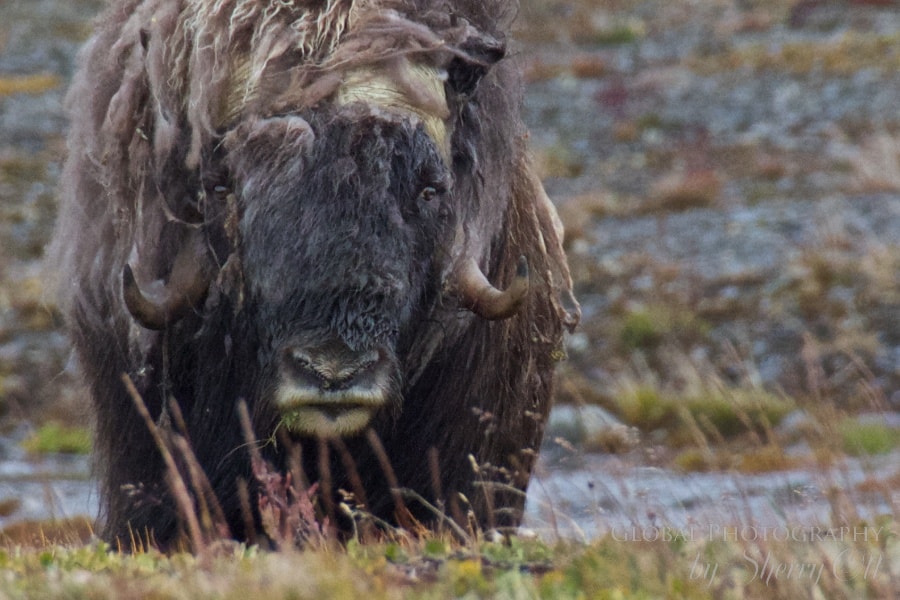
They look like South Dakota buffalo, but they are smaller.
You’ll find many Muskoxen in Nome Alaska too!
Puffins and Guillemots
At all times near the cliffs there were tons of birds flying above us we were clearly outnumbered and that’s always a weird feeling when human beings are outnumbered by another species. We were in their world now. Our guide, Samuel, said that as many birds as we see overhead circling us (thousands!), there were that many below us swimming and fishing in the water. We also learned that Puffins and Guillemots can dive 200 feet deep! They have short wings that aren’t great for flying but super for fishing. They looked like little footballs as they dive-bombed into the water. I was mesmerized by the variety of birds and their lives in the Arctic.
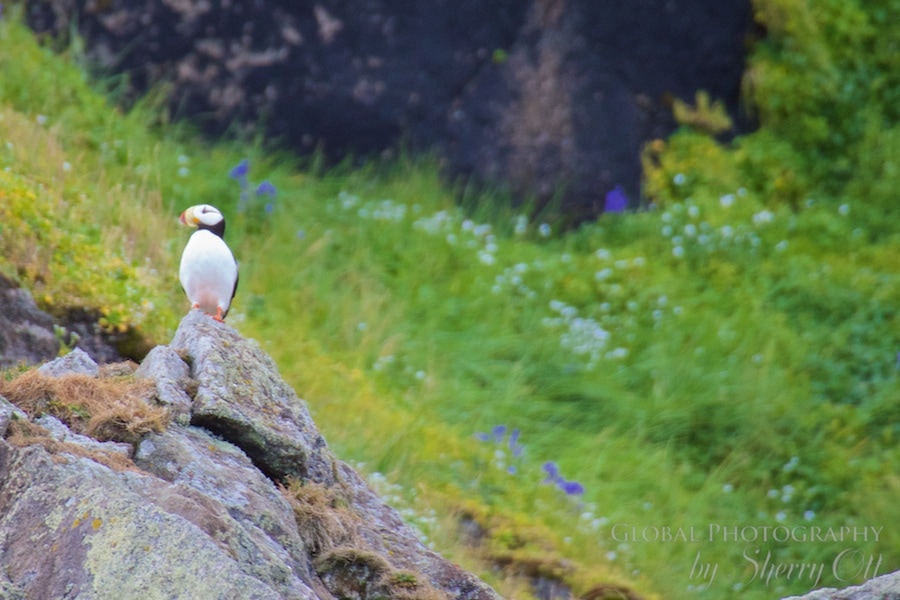
A puffin sits on the cliffs of Diomedes island in the Bering Strait
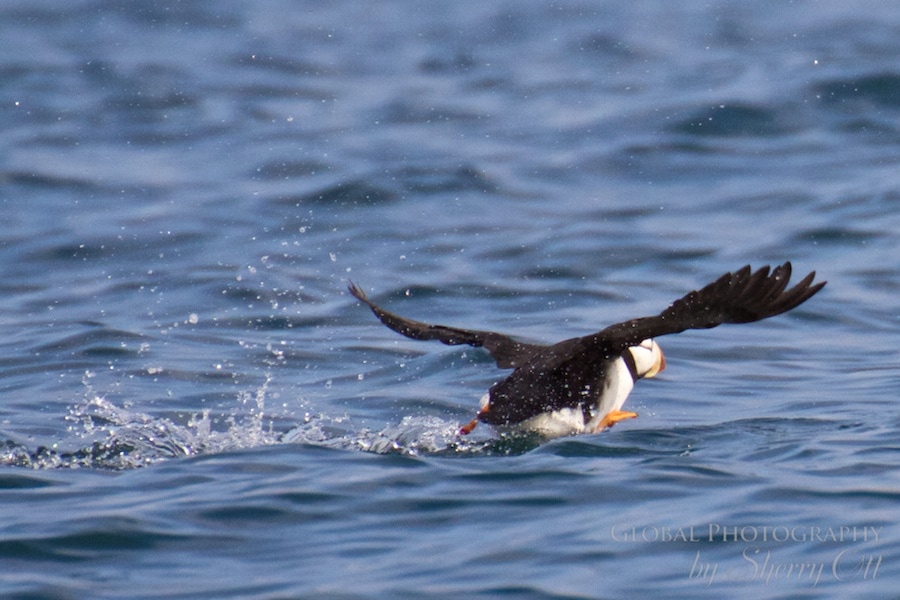
Take off!
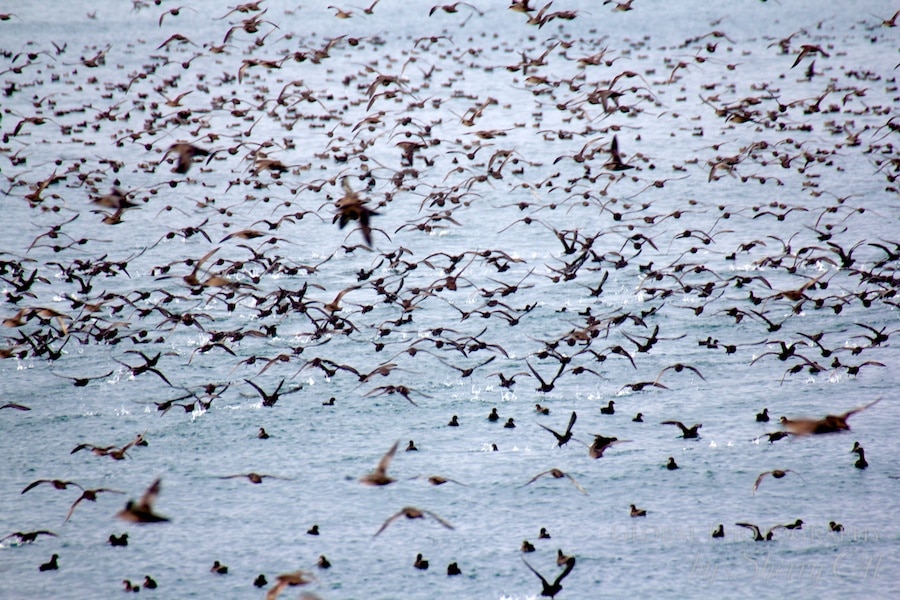
Sheerwaters…outnumber us…a bit freaky
Snow Geese and the Snowy Owl
Not only will you find Snowy Owls on Wrangel Island, but it is also the home of the largest breeding population of Snow Geese in Eurasia. In 2015 – 108,000 nests were recorded on Wrangel Island. The Snow Geese spend their summers on Wrangel and then winter in California or Canada. Regardless – there were plenty of Snow Geese to photograph!
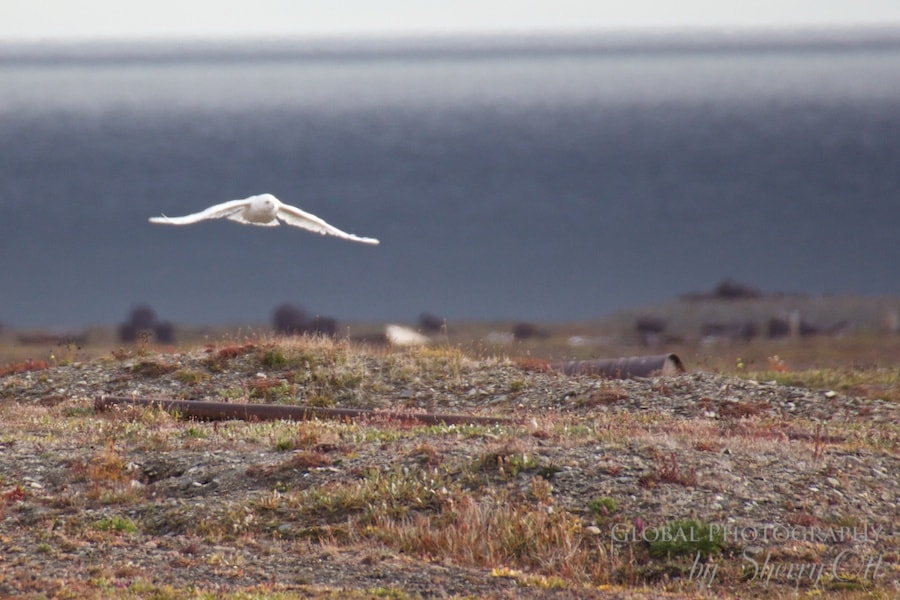
A Snowy Owl on the tundra scanning for food
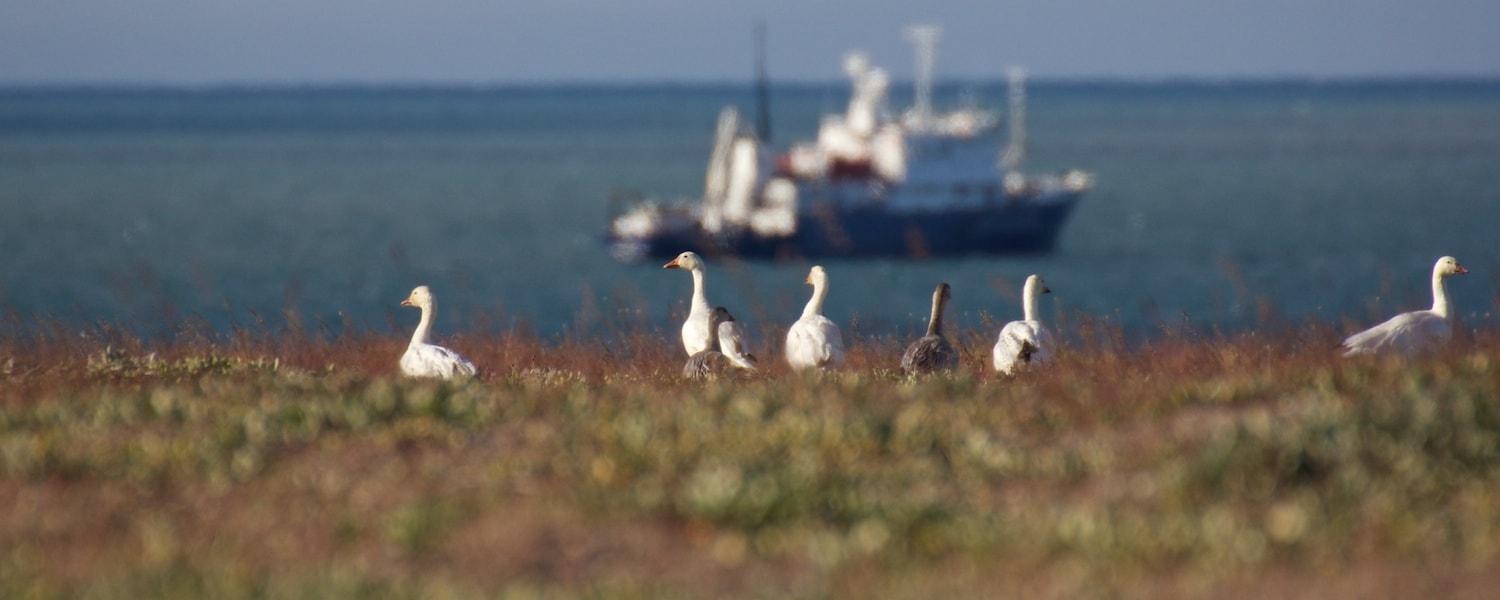
Snow Geese on the Tundra with the Spirit of Enderby in the background
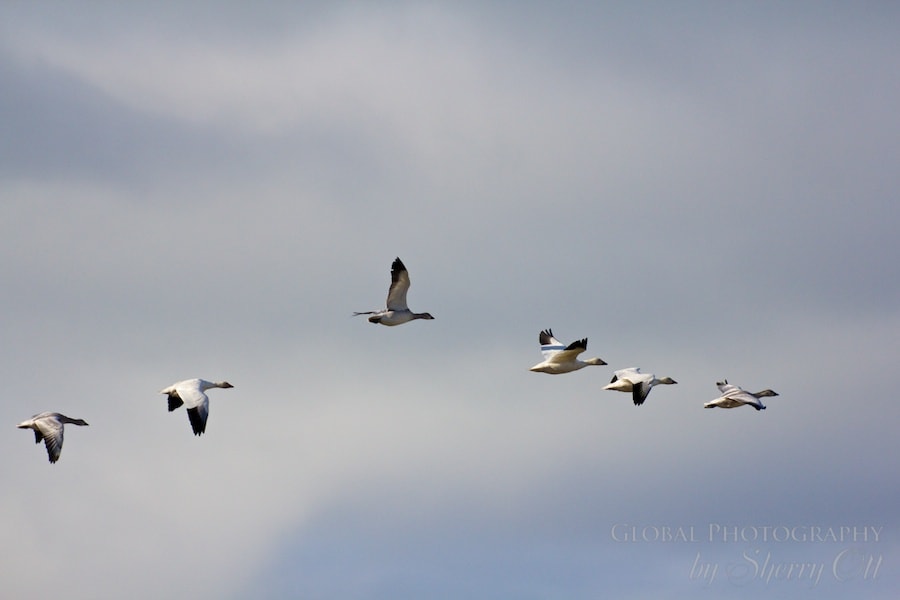
Snow geese in flight
A trip to Wrangel Island and Russia’s Arctic Region was a complete Animals in the Arctic Safari!
Here’s how you can get to the Arctic for your own Arctic Safari:
Heritage Expeditions specializes in expedition cruising to the Arctic Russian Far East on the Spirit of Enderby.
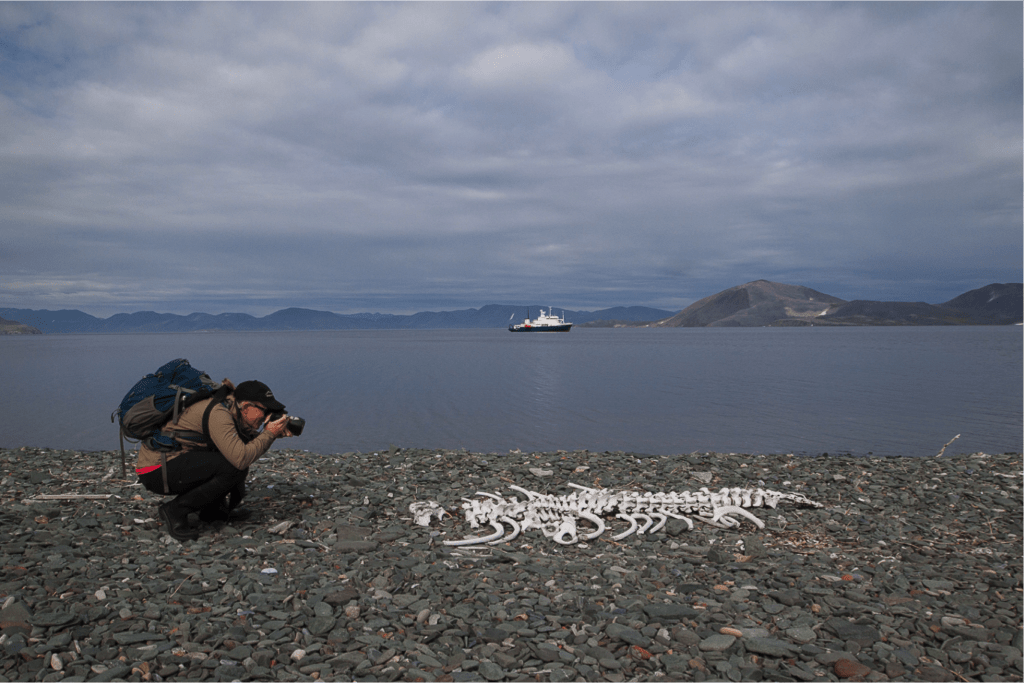
Me shooting a walrus skeleton on shore
Follow my Travels.
Arctic Photography
See all of my photography from the Expedition Cruise to Wrangel Island; tundra landscapes, wildlife, and more.
Arctic Photography
Close encounters…with our skilled expedition leaders
He raises his nose in the air and sniffs at the air, trying to get our scent, but the wind isn’t cooperating with him. He knows we are there, but what we are is a mystery. Just as I’ve never seen a polar bear before, this polar bear has most likely never seen a human before. Since the polar bear’s eyesight isn’t great, they rely on their sense of smell to assess a new situation. He stares right at us, curiosity in his expressions; could we be lunch, should we be feared, or are we harmless. He comes a bit closer; we drift a bit closer. Suddenly he catches it and he has what he wants – our scent. He promptly turns and runs away. This was the beginning of many animals in the Arctic encounters around Wrangel Island.
The Arctic Region, and Wrangel Island in particular, are appealing to travelers for a few reasons.
• It’s remote and rugged
• Few people get to go there
• It’s known for wildlife
Animals in the Arctic
Polar Bears
Humans want to see polar bears, bears don’t want to see us. This is an important fact to keep in mind when viewing these gentle looking creatures.
The Arctic islands play important role in the polar bear life cycle. They need alternative platforms to survive if and when the ice disappears. Wrangel Island is perfect for them; it’s a big landmass with diverse landscape in the midst of a highly productive marine habitats. There is optimal hunting (yes…those walrus could be lunch…) in surrounding sea and island. But the polar bears on Wrangel are in decline, much like the sea ice. Since 1990 optimal ice habitats are disappearing the number of females that den on Wrangel has decreased about four times compared to the 1990s. Not only does Mother Nature play a role in this, but so do humans and poaching.
We arrived at Wrangel Island right when the sea ice had disappeared and most of bears had just come ashore. They seemed all pretty fat and happy.

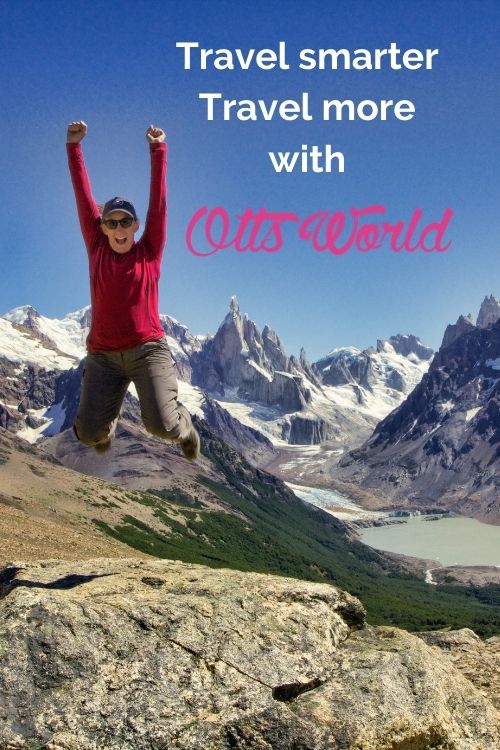
By Darlene Foster February 4, 2016 - 9:18 am
Totally amazing photographs and video!! Buen Trabajo!
By Jared February 4, 2016 - 11:22 am
These are great Sherry. The walruses are my favorite – they are cute in an ugly sort of way! Polar bears look kind of funny up close too with their head that looks like it’s too small for their body. What a great experience.
By Sherry February 5, 2016 - 8:31 am
Ha! They ARE cute-ugly!! I had never seen one before and they were much larger than I had imagined for some reason…and smellier.
By Carlton McEachern February 5, 2016 - 1:10 am
Great job Sherry. Are these with the Sigma 50-500 mm. Looks like it stood you in good stead. This certainly would be an experience of a lifetime.
By Sherry February 5, 2016 - 8:30 am
Hi Carlton – yes these pic were using the Sigma 50-500. It took me a while to get used to it – but I started getting the hang out it after a few days. Wildlife photography is a whole new beast to me! Did you see the post I did on the Lens and tips?
By Leigh | Campfires & Concierges February 10, 2016 - 12:25 pm
Such diversity! Puffins are my favorite – watching a puffin with a full belly struggle to get air was one of my favorite memories from Alaska!
By Izy berry February 10, 2016 - 6:59 pm
This animals in the nature they are so stunning is sad when you watch this animals in the zoo
By International Honeymoon Packages February 12, 2016 - 7:06 am
I thought wild life photography is dangerous, how was your experience, Is it true,but one more thing that this is quite intresting. thanks for sharing you thought for wildlife photography..